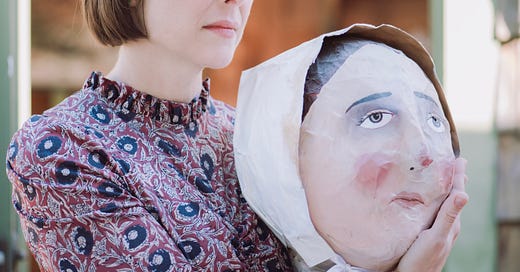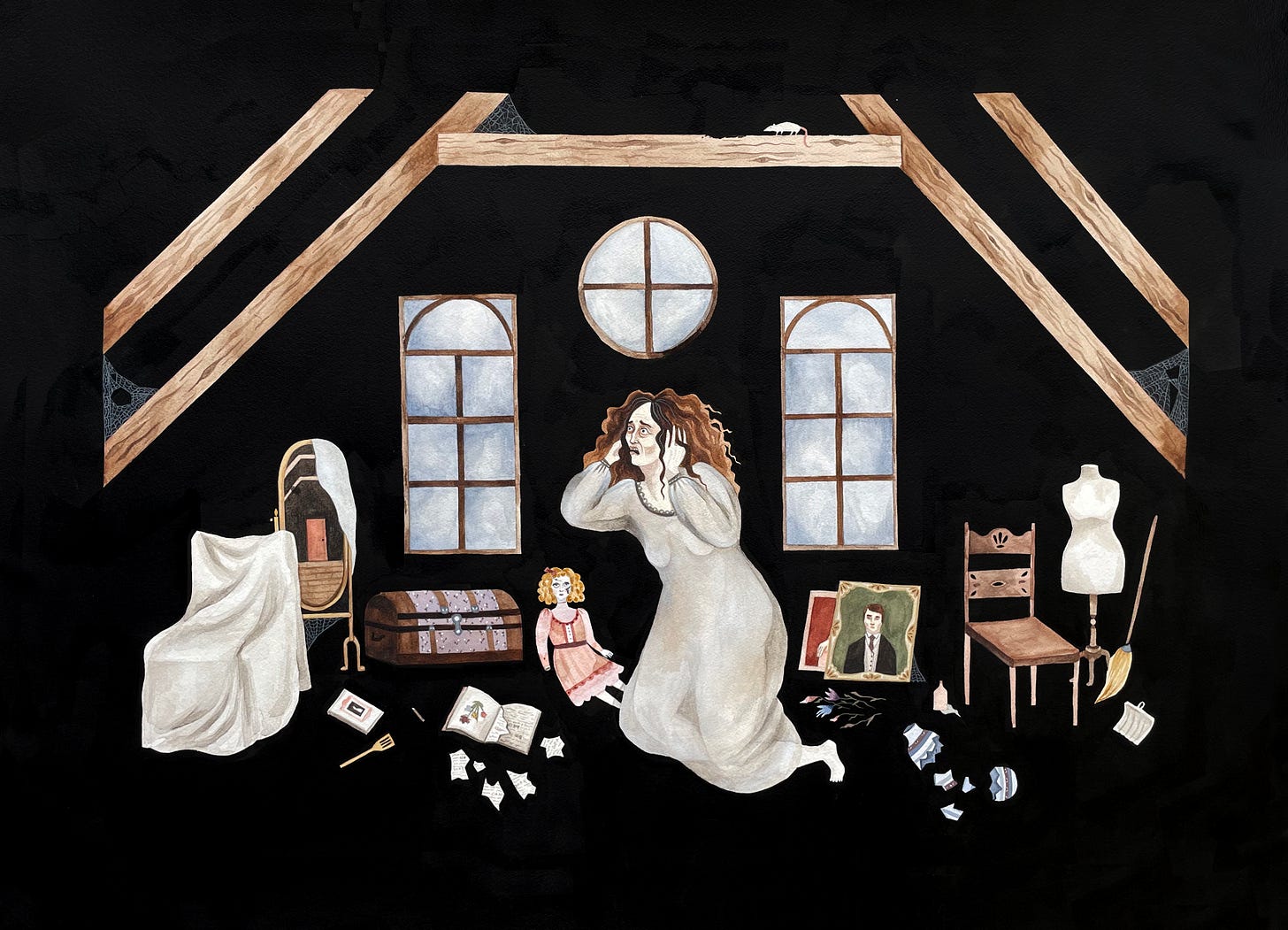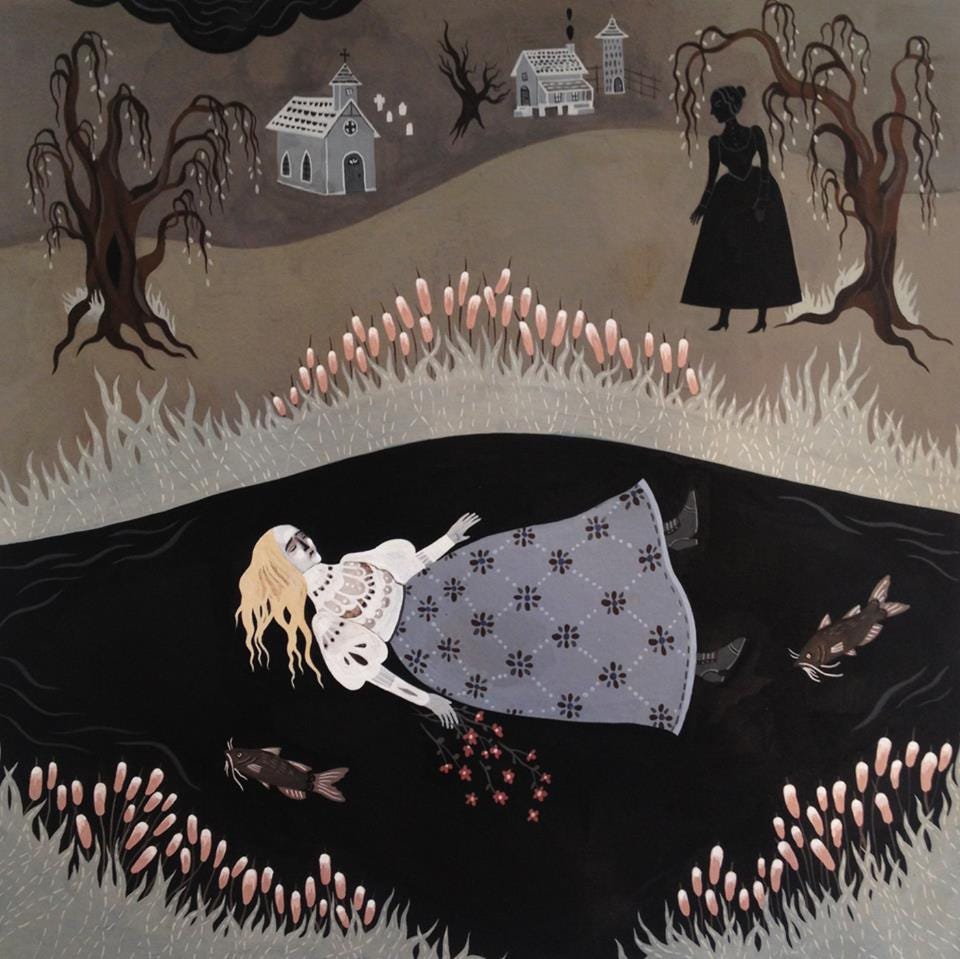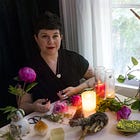CR 024: Katy Horan on Illustrating Witches and Murder Ballads
The multidisciplinary artist discusses her work on “Literary Witches,” her creative process, and her love of the dark side.
Katy Horan’s work is rife with trauma, pain, and longing. Through paintings, drawings, sculptures, and video, Horan explores female archetypes and experiences, pulling from a variety of sources—including folklore, horror films, feminism, music, and history—for inspiration. A 2003 graduate of the Rhode Island School of Design (RISD), Horan is most widely known for her work on Literary Witches: A Celebration of Magical Women Writers, a collaboration with Taisia Kitaiskaia that was published as both a book and oracle deck and was named a Best Book of 2017 by NPR. Her next project, Murder Ballads: Illustrated Lyrics & Lore, is due out in April 2025.
One might think, given her work, that Horan would come across as dark, dour, and mysterious in person. And yet, a peek at her social media posts (like this one, this one, or this one), and it’s apparent that she’s actually...kind of a goofball. “I don’t know how I ended up being such a weirdo externally,” she says, laughing. “I’ve been through a lot in my life. All the trauma in the work comes from a real place. I’m familiar with it, let’s put it that way. And I think that humor is clearly a coping mechanism for me. I go to horrifically gory horror films and just laugh my way through it. A therapist could probably say a lot on the subject. But to me, the darkness and the humor exist together. And I guess [one] gets directed towards the work, and one is just how I interact with the world.”
A longtime fan of “dark stuff,” Horan says her biggest influence is “the Scary Stories to Tell in the Dark books from the ’80s. The illustrations are terrifying, and the stories are scary, but they’re also folklore based. I’ve just always loved dark stuff.”
Over a recent Zoom call, Horan and I discussed her creative process, her advice for aspiring artists, and the worst professional rejection she’s received.
This content contains affiliate links. I am an affiliate of Bookshop.org and I will earn a commission if you click through and make a purchase.
SANDRA EBEJER: Tell me about your background. Were you an artist from a young age? When did you decide to pursue this as a career?
KATY HORAN: I’m from Houston, Texas. I was raised in a normal, not arts-focused home. My mom did put me in art classes when I was young, so I wasn’t surrounded by anyone who was an artist, but my interest in art was encouraged. You know when [someone asks], “What do you want to be when you grow up?” I always said, “A fashion designer” or something creative. I never imagined anything other than that. I don’t know why; it wasn’t modeled for me.
I got into USC for costume design. I was going to do acting, because I did theater in high school. They made me choose [a major] and I chose costume design, but when I started getting into the classes, I started losing interest in the actual making of costumes. I was like, “I don’t know if I actually want to make costumes. I just want to draw them.” So I started thinking more about illustration, and I switched to studio art at USC for another semester. Then I dropped out of USC, and I got into RISD, where I majored in illustration.
You’ve referred to Tori Amos as one of the few musical loves of your life. Where do you pull inspiration from? Do you find certain music or films or books influence your work?
Very, very much. I don’t get influenced by fine art in the way I think is expected, especially of someone who’s done a lot of fine art. I’m a little weird because I’m not looking at art, generally. I’m looking at film, mostly. I would say horror film is probably my biggest influence, but also books, as well. I like to read a lot of old folklore. I like to read folklore theory. I like to read feminist horror theory, as well. Fairy tale studies is a niche set of academia that I find fascinating and interesting. Also witches—I’ve had a long relationship with the archetype of the witch in my work. And so books about the witch, books about witch trials, history I pull from, because storytelling is at the root of everything I do. And while I definitely pull imagery from film, the stories themselves [are influenced by] what I like to read.
I’ll also say music. I listen to movie scores while I work, because movie scores are beautifully designed. It’s magic. I don’t understand it. It’s designed to elicit very specific emotional responses. This is the same with some folk music. There’s something intangible that I feel in music sometimes, that I don’t know any way to articulate, that I try to bring into my work, or I’m trying to capture with my work. There’s always a sense of trying to capture a feeling, an atmosphere, a sense of something.
Do you begin a painting knowing what it is you want to do, does it happen organically, or is it a mixture of the two?
It’s a mixture of the two. It can be a very chaotic process. I’m very impatient, so sometimes I’ll just go off half-cocked and put something on the wall just because I’m feeling frustrated and impatient to get something going. I’ll be like, “I’m going to start organic and just see what happens.” It never works out, ever. So while I’d like to say that I have a process that’s routine, it’s not. Sometimes it’s me throwing stuff against the wall, and it not working. Sometimes I have a picture in my head. Pretty much anything that gets actually finished came from a picture I had in my head that maybe I did a little thumbnail sketch. But really what I do is I don’t prepare, and then I dive in, and then I have to fight for my life the whole time to make it work, because I’m so terrible at taking the time to prepare first. Which is why I illustrate digitally now. It works for my process. I just want to figure it out as I go along.
You’ve shared some deeply personal stories through your work. Do you find that process cathartic? Triggering? Both?
The act of me doing it is not healing. By the time I’m talking about something, I’ve done a lot of work around it, and I am pretty comfortable talking about it. What I find cathartic or healing or therapeutic about it is refusing to keep it a secret. That’s the world I was raised in, so for me to stand out and say something that happened, that normally I would have had to keep a secret, that feels great to me. That’s very healing. Also, I feel strongly [that] people need to understand that bad things do happen all the time. They need to understand how commonplace all types of violence are. I feel it’s so important to show people, to make people face it in some capacity. That feels healing and empowering to me, for sure.
The most widely known project you’ve worked on thus far is Literary Witches. How did that project come about?
It was so fated. I owe the writer of Literary Witches, Taisia Kitaiskaia, so much. Before she contacted me in early 2015, I was fighting for my career. It was getting hard. I had been wanting to do illustration for a long time, but I was struggling to get noticed. Also, I’m different. There’s a reason I wasn’t getting hired to illustrate children’s books straight out of art school. I’m not the most commercial choice, we’ll just put it that way. And I couldn’t seem to get into a gallery where I could actually make some money.
So Taya, as she is casually known, saw a piece of mine on Tumblr or something. She reached out because she was trying to make a book out of her “Ask Baba Yaga” advice column that was on The Hairpin. She asked me to do illustrations for the pitch for that book. That fell through very quickly after I had started doing some sketches for it and when that fell through, she was like, “Well, I still want to work with you. I have this idea for a set of tarot cards that are all women writers.” She started writing some stuff, and I started sketching. We chose five [writers to start with]. We dropped the tarot card idea pretty quickly, because her friends at Electric Literature said, “This sounds fun. We’ll run it.” So we did the first five, and they were put on Electric Literature, and that’s when a literary agent contacted us and was like, “This needs to be a book.” Through her, we got the book, and then we got the [oracle] cards. That came a couple years later. That was a while ago, before I was illustrating digitally. That might have been the last thing I illustrated analog.
Were you already familiar with the authors in the book and the deck? How much research did you have to do to ensure you were representing them authentically in your art?
That’s a great question, because there were some I did not know, and I’m so glad I know them now. It was a very breakneck process. A lot of them I knew well enough to not have to do any research. I was like, “Toni Morrison. Got it!” I also leaned heavily on the text, because the imagery that Taya conjured in her writing was just so perfect. Luckily, there’s a lot of poets and there are some short story writers. So, for example, I had never read Flannery O’Connor before, so I read a couple of her short stories. I had never read Sylvia Plath’s poetry, so I ran through all of that. Then there are a couple that were novelists. I basically had two to three weeks for each illustration, as far as execution and research, so I found online CliffsNotes and I would pick out what I could. But it’s great because it was an awesome education for me.
Now you’ve got the upcoming book on murder ballads. How did that come about?
We moved from New York to Austin in 2009, but I was in New York for six years before that. I don’t know when in my time there, but one night my husband’s friend from home was in town playing with a bluegrass band. I heard them play a song that had these insane lyrics about a [woman] getting really jealous of her sister because they loved the same man, so she threw her in the river and killed her. And then the dead sister floats down to a pond where a guy comes along and turns her bones and hair into a fiddle. I heard that, and I was like, “What?” That’s the exact kind of imagery that I love. I just ate it up.
So I learned what murder ballads were from there. Then in about 2011, when I was still trying to get illustration jobs, I had the idea for the book. But that idea was different. I thought it would be cool to be an album, and then illustrations in the liner notes. I chose two different ballads, one of them being the one I had heard that night, which is originally called “The Twa Sisters,” but better known as “Dreadful Wind and Rain.” The Grateful Dead sang it. Gillian Welch has an awesome version of it. So it’s somewhat well known in folk music. And I chose another one called “The Bloody Gardener.” I did illustrations for them, but I didn’t know anybody in the publishing industry. I was [sending] it around to anyone I knew who might know someone who knew someone who knew about books. But I just wasn’t there yet, so I put that aside while I did Literary Witches.
Then in 2022, I didn’t have anything coming up, and I was like, “I don’t know what to do.” I did have an agent, and I was sending her ideas, but she wasn’t liking any of them. I had also illustrated Ask Baba Yaga volume two with Taya, so I knew the editor at Andrews McMeel. And it was like a Hail Mary. I was like, “Let me just get some of these old ideas I have because I need to get some kind of project rolling.” So I hail Mary-ed it to the editor I worked with, and she liked it. That was in ’22. Then there was some shifting. I had to change agents, and then we had to do the whole pitch, and blah blah. I started officially working on it in summer of last year.
One thing that I think is not talked about often enough is rejection. I think when people see you’ve gotten great press, you’ve worked on multiple books, and you have this other book that’s going to print, you’re quote-unquote successful. But I saw on Instagram that you had put together illustrations around the overturn of Roe v. Wade that you’d hope to put into book form, but it didn’t happen. Can you talk about that process and how you deal with it when you know in your heart that something is a great idea, but you can’t get it off the ground?
That’s very kind for you to say all that stuff about success. I’ve been doing this for 20 years. I have experienced massive amounts of rejection. With the abortion comics—oh my God, that was one of the worst rejection situations I’ve ever experienced. I set out to do that as a response to Roe being overturned and I was really happy with that first comic. I did exactly what I wanted to do with it. I sent it to my agent, and I was like, “I think this would be important to be a book. We need this.” Because at the time, there was so much bullshit by people talking about, “Then don’t have sex. Just keep your legs closed.” It was so reductive. No one was talking about the actual lives. No nuance or anything. Every one of these stories is different. Let’s tell the human stories! I got about 20 [anonymous] stories, and they’re all such a variety of life experiences and circumstances.
How did the stories come to you? Did you ask for people to send them in?
Yeah, I set up a submission form on my website, and I put it on Instagram. Bust Magazine shared it for me. Anyways, I did that [first comic], and my agent agreed [to the project]. So we put together the pitch, and I storyboarded a second one, so I have a second comic that is storyboarded and not finished. We sent it around, and people were like, “We’re not touching that.” We were close with one publisher, but they didn’t understand my choice to illustrate it in the way I did, which is with these humanoid figures. I did that for very specific reasons, because I did not want to give any specific race or gender assignment, because I don’t know who wrote these stories to me. And also, I needed to find a way to get to the emotional core of these stories with the imagery.
That project meant so much to me, and it was out on submission for about three months in the beginning of 2023 and it was so painful. I’d never gone through having your own book on submission and it just doesn’t happen, especially when you and your agent are like, “This is so important right now. There’s so many women in publishing. Surely, surely, they all want—” No. They didn’t. They didn’t want it. The way I got over that was I said, “I’m going to move forward.” We were getting ready to get Murder Ballads together, but we decided that the abortion stories [book] was actually so much more timely and important. I was like, “Fine. Murder Ballads.” It was already pitched to a publisher, so we knew that was something we could actually make happen.
We’ll see. I don’t know when publishers are going to want a book like that. At this point, I feel like I would need to broaden the subject to a degree. I mean, I’m in Texas. Nationally, people hear stories about what’s happening with women here, but I’ve been reading the papers since the bans began, and it’s been terrifying.
Do you ever have creative blocks or periods where you’re just not making art?
Definitely right now, because I’m just wrapping [Murder Ballads] up. And that’s okay. I don’t normally handle it well, but I’m handling it okay. I think my issue is I push myself too hard, instead of allowing myself to do all the nurturing things that are just as much a part of our process, like letting yourself sit and read and exercise. It’s usually when I’m creatively drained that I go through this period of panic because I’m just so burnt out. Because whenever there’s a project that’s been finished, it’s been finished in a very stressed-out state. I oftentimes will idealize what it’s like to be in the studio and not be stressed and be in the flow and be engaged with whatever. I long to get that back, but in order to get back to that place of a flow state with creativity, I have to let myself step way back. And I have to let myself just enjoy the things I enjoy, and that’s really hard for me to do. In fact, that’s right now what I’m trying to do. Now is the time I need to do that. I’m getting there. I’m working on it. In the past, I’ve been like a wrecking ball through the slower parts of the process. It’s not the healthiest way to do it.
What advice would you give to aspiring artists?
From a financial, logistical, practical point of view, going into a trade job—something that isn’t corporate, something that won’t suck up your time beyond what you are actually paid to do—is, to me, a healthier way to make money while also trying to be an artist, because it’s not going to suck from you, and it’s a reliable gig.
Artistically, I would say your intuition is the most important thing when it comes to making art of any kind. If you want to make the best art that you can make, then you have to make the art that is most original to yourself. Don’t look at what other people are doing. Don’t compare yourself to other people. I’m speaking as someone who never really fit in perfectly in artistic spaces. I never fit in perfectly in the fine art world. I was too illustration-y over there. It took a while for people to want what I do, illustration-wise.
Especially for women artists, don’t underestimate the long game. I got out of art school and there were some people I went to school with who blew up on the underground, low-brow gallery scene really fast. And it was like, “Wow! Damn.” I was all jealous and everything. But that didn’t really last. Some of them dropped when trends changed. So the long game is important, as is your own intuition about what you want to make art about, how you want to make it. If you’re working on something and there’s a voice nagging you that says it doesn’t feel quite right, listen to it. Don’t judge the voice. It’s really important.
To learn more about Katy Horan, visit her website.
To pre-order Murder Ballads: Illustrated Lyrics & Lore, click here.
This interview has been edited for clarity and length.
You might also enjoy…










